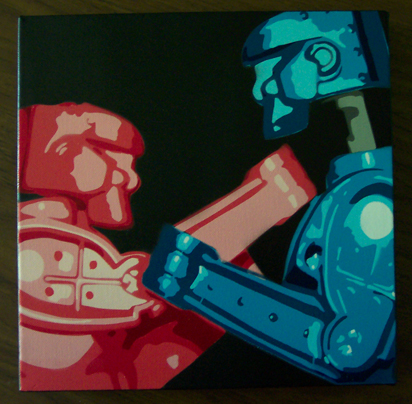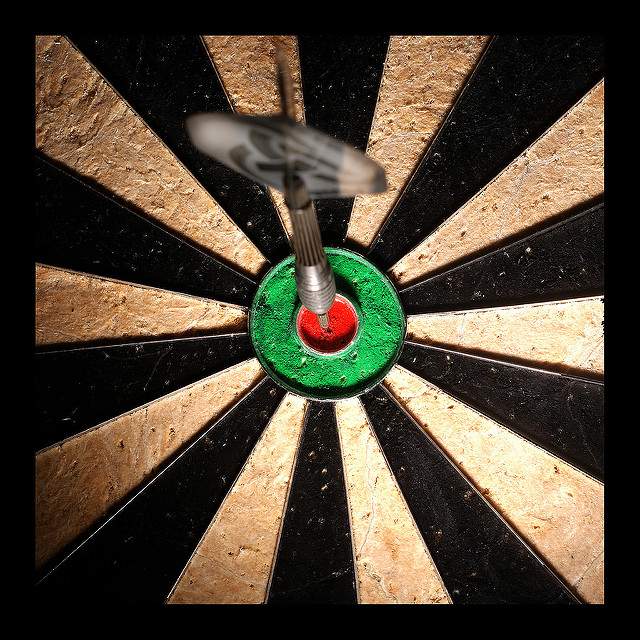Archive for the ‘How To’ Category
To improve innovation, use fewer words.
 Everyone knows innovation is difficult, but there’s no best way to make it easier. And everyone knows there’s plenty of opportunities to make innovation more effective, but, again, there’s no best way. Clearly, there are ways to improve the process, and new tools can help, but the right process improvements depend on the existing process and the specific project. And it’s the same for tools – the next tool depends on the existing toolbox and the new work required by the project. With regard to tools and processes, the right next steps are not universal.
Everyone knows innovation is difficult, but there’s no best way to make it easier. And everyone knows there’s plenty of opportunities to make innovation more effective, but, again, there’s no best way. Clearly, there are ways to improve the process, and new tools can help, but the right process improvements depend on the existing process and the specific project. And it’s the same for tools – the next tool depends on the existing toolbox and the new work required by the project. With regard to tools and processes, the right next steps are not universal.
But with all companies’ innovation processes, there is a common factor – the innovation process is run by people. Regardless of process maturity or completeness, people run the process. And this fundamental cuts across language, geography and company culture. And it cuts across products, services, and business models. Like it or not, innovation is done by people.
At the highest level, innovation converts ideas into something customers value and delivers the value to them for a profit. At the front end, innovation is about ideas, in the middle, it’s about problems and at the back end, it’s about execution. At the front, people have ideas, define them, evaluate them and decide which ones to advance. In the middle, people define the problems and solve them. And at the back end, people define changes to existing business process and run the processes in a new way.
Tools are a specialized infrastructure that helps people run lower-level processes within the innovation framework. At the front, people have ideas about new tools, or how to use them in a new way, define the ideas, evaluate them, and decide which tools to advance. In the middle, people define problems with the tools and solve them. And at the back end, they run the new tools in new ways.
With innovation processes and tools, people choose the best ideas, people solve problems and people implement solutions.
In order to choose the best ideas, people must communicate the ideas to the decision makers in a clear, rich, nuanced way. The better the idea is communicated, the better the decision. But it’s difficult to communicate an idea, even when the idea is not new. For example, try to describe your business model using just words. And it’s more difficult when the idea is new. Try to describe a new (untested) business model using just your words. For me, words are not a good way to communicate new ideas.
Improved communication improves innovation. To improve communication of ideas, use fewer words. Draw a picture, create a cartoon, make a storyboard, or make a video. Let the decision maker ask questions of your visuals and respond with another cartoon, a modified storyboard or a new sketch. Repeat the process until the decision maker stops asking questions. Because communication is improved, the quality of the decision is improved.
Improved problem solving improves innovation. To improve problem-solving, improve problem definition (the understanding of problem definition.) Create a block diagram of the problem – with elements of the system represented by blocks and labeled with nouns, and with actions and information flow represented by arrows labeled with verbs. Or create a sketch of the customer caught in the act of experiencing the problem. Define the problem in time (when it happens) so it can be solved before, during or after. And in all cases, limit yourself to one page. Continue to modify the visuals until there’s a common definition of the problem (the words stop.) When the problem is defined and communicated in this way, the problem solves itself. Problem-solving is seven-eighths problem definition.
Improved execution improves innovation. To improve execution, improve clarity of the definition of success. And again, minimize the words. Draw a picture that defines success using charts or graphs and data. Create the axes and label them (don’t forget the units of measure). Include data from the baseline product (or process) and define the minimum performance criterion in red. And add the sample size (number of tests.) Use one page for each definition of success and sequence them in order of importance. Start with the work that has never been done before. And to go deeper, define the test protocol used to create the data.
For a new business model, the one-page picture could be a process diagram with new blocks for new customers or partners or new arrows for new information flows. There could be time requirements (response time) or throughput requirements (units per month). Or it could be a series of sketches of new deliverables provided by the business model, each with clearly defined criteria to judge success. When communicated clearly to the teams, definitions of success are beacons of light that guide the boats as the tide pulls them through the project or when uncharted rocks suddenly appear to starboard.
Innovation demands communication and communication demands mechanisms. In the domain of uncertainty, words are not the best communicators. Create visual communication mechanisms that distill and converge on a common understanding.
A picture isn’t worth a thousand words, it gets rid of a thousand.
Image credit – Michael Coghlan
How To Reduce Innovation Risk
 The trouble with innovation is it’s risky. Sure, the upside is nice (increased sales), but the downside (it doesn’t work) is distasteful. Everyone is looking for the magic pill to change the risk-reward ratio of innovation, but there is no pill. Though there are some things you can do to tip the scale in your favor.
The trouble with innovation is it’s risky. Sure, the upside is nice (increased sales), but the downside (it doesn’t work) is distasteful. Everyone is looking for the magic pill to change the risk-reward ratio of innovation, but there is no pill. Though there are some things you can do to tip the scale in your favor.
All problems are business problems. Problem solving is the key to innovation, and all problems are business problems. And as companies embrace the triple bottom line philosophy, where they strive to make progress in three areas – environmental, social and financial, there’s a clear framework to define business problems.
Start with a business objective. It’s best to define a business problem in terms of a shortcoming in business results. And the holy grail of business objectives is the growth objective. No one wants to be the obstacle, but, more importantly, everyone is happy to align their career with closing the gap in the growth objective. In that way, if solving a problem is directly linked to achieving the growth objective, it will get solved.
Sell more. The best way to achieve the growth objective is to sell more. Bottom line savings won’t get you there. You need the sizzle of the top line. When solving a problem is linked to selling more, it will get solved.
Customers are the only people that buy things. If you want to sell more, you’ve got to sell it to customers. And customers buy novel usefulness. When solving a problem creates novel usefulness that customers like, the problem will get solved. However, before trying to solve the problem, verify customers will buy what you’re selling.
No-To-Yes. Small increases in efficiency and productivity don’t cause customers to radically change their buying habits. For that your new product or service must do something new. In a No-To-Yes way, the old one couldn’t but the new one can. If solving the problem turns no to yes, it will get solved.
Would they buy it? Before solving, make sure customers will buy the useful novelty. (To know, clearly define the novelty in a hand sketch and ask them what they think.) If they say yes, see the next question.
Would it meet our growth objectives? Before solving, do the math. Does the solution result in incremental sales larger than the growth objective? If yes, see the next question.
Would we commercialize it? Before solving, map out the commercialization work. If there are no resources to commercialize, stop. If the resources to commercialize would be freed up, solve it.
Defining is solving. Up until now, solving has been premature. And it’s still not time. Create a functional model of the existing product or service using blocks (nouns) and arrows (verbs). Then, to create the problem(s), add/modify/delete functions to enable the novel usefulness customers will buy. There will be at least one problem – the system cannot perform the new function. Now it’s time to take a deep dive into the physics and bring the new function to life. There will likely be other problems. Existing functions may be blocked by the changes needed for the new function. Harmful actions may develop or some functions will be satisfied in an insufficient way. The key is to understand the physics in the most complete way. And solve one problem at a time.
Adaptation before creation. Most problems have been solved in another industry. Instead of reinventing the wheel, use TRIZ to find the solutions in other industries and adapt them to your product or service. This is a powerful lever to reduce innovation risk.
There’s nothing worse than solving the wrong problem. And you know it’s the wrong problem if the solution doesn’t: solve a business problem, achieve the growth objective, create more sales, provide No-To-Yes functionality customers will buy, and you won’t allocate the resources to commercialize.
And if the problem successfully runs the gauntlet and is worth solving, spend time to define it rigorously. To understand the bedrock physics, create a functional of the system, add the new functionality and see what breaks. Then use TRIZ to create a generic solution, search for the solution across other industries and adapt it.
The key to innovation is problem solving. But to reduce the risk, before solving, spend time and energy to make sure it’s the right problem to solve.
It’s far faster to solve the right problem slowly than to solve the wrong one quickly.
Image credit – Kate Ter Haar
See differently to solve differently.
 There are many definitions for creativity and innovation, but none add meaningfully to how the work is done. Though it’s clear why the work is important – creativity and innovation underpin corporate prosperity and longevity – it’s especially helpful to know how to do it.
There are many definitions for creativity and innovation, but none add meaningfully to how the work is done. Though it’s clear why the work is important – creativity and innovation underpin corporate prosperity and longevity – it’s especially helpful to know how to do it.
At the most basic level, creativity and innovation are about problem solving. But it’s a special flavor of problem solving. Creativity and innovation are about problems solving new problems in new ways. The glamorous part is ‘solving in new ways’ and the important part is solving new problems.
With continuous improvement the same problems are solved over and over. Change this to eliminate waste, tweak that to reduce variation, adjust the same old thing to make it work a little better. Sure, the problems change a bit, but they’re close cousins to the problems to the same old problems from last decade. With discontinuous improvement (which requires high levels of creativity and innovation) new problems are solved. But how to tell if the problem is new?
Solving new problems starts with seeing problems differently.
Systems are large and complicated, and problems know how to hide in the nooks and crannies. In a Where’s Waldo way, the nugget of the problem buries itself in complication and misuses all the moving parts as distraction. Problems use complication as a cloaking mechanism so they are not seen as problems, but as symptoms.
Telescope to microscope. To see problems differently, zoom in. Create a hand sketch of the problem at the microscopic level. Start at the system level if you want, but zoom in until all you see is the problem. Three rules: 1. Zoom in until there are only two elements on the page. 2. The two elements must touch. 3. The problem must reside between the two elements.
Noun-verb-noun. Think hammer hits nail and hammer hits thumb. Hitting the nail is the reason people buy hammers and hitting the thumb is the problem.
A problem between two things. The hand sketch of the problem would show the face of the hammer head in contact with the surface of the thumb, and that’s all. The problem is at the interface between the face of the hammer head and the surface of the thumb. It’s now clear where the problem must be solved. Not where the hand holds the shaft of the hammer, not at the claw, but where the face of the hammer smashes the thumb.
Before-during-after. The problem can be solved before the hammer smashes the thumb, while the hammer smashes the thumb, or after the thumb is smashed. Which is the best way to solve it? It depends, that’s why it must be solved at the three times.
Advil and ice. Solving the problem after the fact is like repair or cleanup. The thumb has been smashed and repercussions are handled in the most expedient way.
Put something between. Solving the problem while it happens requires a blocking or protecting action. The hammer still hits the thumb, but the protective element takes the beating so the thumb doesn’t.
Hand in pocket. Solving the problem before it happens requires separation in time and space. Before the hammer can smash the thumb it is moved to a safe place – far away from where the hammer hits the nail.
Nail gun. If there’s no way for the thumb to get near the hammer mechanism, there is no problem.
Cordless drill. If there are no nails, there are no hammers and no problem.
Concrete walls. If there’s no need for wood, there’s no need for nails or a hammer. No hammer, no nails, no problem.
Discerning between symptoms and problems can help solve new problems. Seeing problems at the micro level can result in new solutions. Looking closely at problems to separate them time and space can help see problems differently.
Eliminating the tool responsible for the problem can get rid of the problem of a smashed thumb, but it creates another – how to provide the useful action of the driven nail. But if you’ve been trying to protect thumbs for the last decade, you now have a chance to design a new way to fasten one piece of wood to another, create new walls that don’t use wood, or design structures that self-assemble.
Image credit – Rodger Evans
Maximize The Learning Ratio
 As creatures of habit, we like to do what we did last time. Outcomes match expectations and things go as planned – no surprises, no delays, no problems. But as creatures swimming in an evolutionary soup, doing what we did last time leads to extinction. Customers’ expectations multiply and competitors mutate into a higher performing organism and eat us. There are two competing functions – do what we did last time to minimize energy and try new things to harden ourselves for the ever more competitive future.
As creatures of habit, we like to do what we did last time. Outcomes match expectations and things go as planned – no surprises, no delays, no problems. But as creatures swimming in an evolutionary soup, doing what we did last time leads to extinction. Customers’ expectations multiply and competitors mutate into a higher performing organism and eat us. There are two competing functions – do what we did last time to minimize energy and try new things to harden ourselves for the ever more competitive future.
You can’t reinvent yourself at every turn or your brain will run out of glucose and you’ll pass out. And you can’t always lounge on the couch or you’ll get out of shape and become a slow-moving snack for the new T-Rex on the block. If the endpoints lead to our demise, the solution must be something like the middle way.
If you can get away with it, do what you did last time – minimum energy living is a good gig if you can get it. With little investment and lots of return, there’s enough for everyone. Plenty to eat and some left over to put in stores for the winter. But plenty to eat and plenty of time to goof off may make for lazy (but happy) tribe members who may be of little use when it’s time to defend the business model against hostile species.
Live frugally to develop a surplus and spend some of it trying new things. Improved fitness is the best way to navigate the landscape, even the landscape still beyond the horizon. More than physical fitness, improved mental fitness is the dominant trait that leads to survival. But doing new work is energy intensive and must be done skillfully.
The primary reason we try new things is to learn. In that way, the new things we try are a means to an end – improved mental fitness. But because doing new is expensive from an energy perspective, the learning ratio (new learning divided by the energy to learn) must be high. First, be clear about what you want to learn because learning the wrong thing costs more energy than resting on the couch. Second, maximize the learning of your experiments.
If you run an experiment where you are 100% sure of the outcome, your learning is zero. You already knew how it would go, so there was no need to run the experiment. The least costly experiment is the one you didn’t have to run, so don’t run experiments when you know how they’ll turn out. If you run an experiment where you are 0% sure of the outcome, your learning is zero. These experiments are like buying a lottery ticket – you learn the number you chose didn’t win, but you learned nothing about how to choose next week’s number. You’re down a dollar, but no smarter.
The learning ratio is maximized when energy is minimized (the simplest experiment is run) and probability the experimental results match your hypothesis (expectation) is 50%. In that way, half of the experiments confirm your hypothesis and the other half tell you why your hypothesis was off track.
We can argue about the energy balance between leveraging best practices and creating new recipes. But, when you want to learn, there can be no argument – maximize the learning ratio.
Image credit – Craig Sunter
Full Circle Innovation
 It’s not enough to sell things to customers, because selling things is transactional and, over time, transactional selling deteriorates into selling on price. And selling on price is a race to the bottom.
It’s not enough to sell things to customers, because selling things is transactional and, over time, transactional selling deteriorates into selling on price. And selling on price is a race to the bottom.
Sales must move from transactional to relational, where people in the sales organization become trusted advisers and then something altogether deeper. At this deeper level of development, the sales people know the business as well as the customer, know where the customer wants to go and provide unique perspective and thoughtful insight. That’s quite a thing for sales, but it’s not enough. Sales must become the conduit that brings the entire company closer to the customer and their their work.
When the customer is trying to figure out what’s next, sales brings in a team of marketing, R&D and manufacturing to triangulate on the future. The objective is to develop deep understanding of the customer’s world. The understanding must go deeper than the what’s. The learning must scrape bottom and get right down to the bedrock why’s.
To get to bedrock, marketing leads learning sessions with the customer. And it all starts by understanding the work. What does the customer do? Why is it done that way? What are the most important processes? How did they evolve? Why do they flow the way they do? These aren’t high-level questions, they are low-level, specific questions, done in front of the actual work.
The mantra – Go to the work.
When the learning sessions are done well, marketing includes experts in manufacturing and R&D. Manufacturing brings their expertise in understanding process and R&D brings their expertise in products and technologies. And to understand the work the deepest way, the tool of choice is the Value Stream Map (VSM).
Cross-organization teams are formed (customer, sales, marketing, manufacturing, and R&D) and are sent out to create Value Steam Maps of the most important processes. (Each team is supported by a VSM expert.) Once the maps are made, all the teams come back together to review the them and identify the fundamental constraints and how to overcome them. The solutions are not limited to new product offerings, rather the solutions could be training, process changes, policy changes, organizational changes or business model changes.
Not all the problems are solved in the moment. After the low hanging fruit is picked, the real work begins. After returning home, marketing and R&D work together to formulate emergent needs and create new ways to meet them. The tool of choice is the IBE (Innovation Burst Event).
To prepare for the IBE, marketing and R&D formalize emergent needs and create Design Challenges to focus the IBE teams. Solving the Design Challenges breaks the conflicts creates novel solutions that meet the unmet needs. In this way, the IBE is a pull process – customer needs create the pull for a solution.
The IBE is a one or two-day event where teams solve the Design Challenges by building conceptual prototypes (thinking prototypes). Then, they vote on the most interesting concepts and create a build plan (who, what, when). The objective of the build plan is to create a Diabolically Simple Prototype (DSP), a functional prototype that demonstrates the new functionality. What makes it diabolical is quick build time. At the end of the IBE is a report out of the build plan to the leader who can allocate the resources to execute it.
In a closed-loop way, once the DSP is built, sales arranges another visit to the customer to demonstrate the new solution. And because the prototype designed to fulfill the validated customer need, by definition, the prototype will be valuable to the customer.
This full circle process has several novel elements, but the magic is in the framework that brings everyone together. With the process, two companies can work together effectively to achieve shared business objectives. And, because the process brings together multiple functions and their unique perspectives, the solutions are well-thought-out and grounded in the diversity of the collective.
Image credit – Gerry Machen
With innovation you’ve got to feel worthy of the work.
 When doing work that’s new, sometimes it seems the whole world is working against you. And, most of the time, it is. The outside world is impossible to control, so the only way to deal with external resistance is to pretend you don’t hear it. Shut your ears, put your head down and pull with all your might. Define your dream and live it. And don’t look back. But what about internal resistance?
When doing work that’s new, sometimes it seems the whole world is working against you. And, most of the time, it is. The outside world is impossible to control, so the only way to deal with external resistance is to pretend you don’t hear it. Shut your ears, put your head down and pull with all your might. Define your dream and live it. And don’t look back. But what about internal resistance?
Where external resistance cannot be controlled and must be ignored, internal resistance, resistance created by you, can be actively managed. The best way to deal with internal resistance is to prevent its manufacture, but very few can do that. The second best way is to acknowledge resistance is self-made and acknowledge it will always be part of the innovation equation. Then, understand the traps that cause us to create self-inflicted resistance and learn how to work through them.
The first trap prevents starting. At the initial stage of a project, two unstated questions power the resistance – What if it doesn’t work? and What if it does work? If it doesn’t work, the fear is you’ll be judged as incompetent or crazy. The only thing to battle this fear is self-worth. If you feel worthy of the work, you’ll push through the resistance and start. If it does work, the fear is you won’t know how to navigate success. Again, if you think you’re worthy of the work (the work that comes with success), you and your self-esteem will power through the resistance and start.
Underpinning both questions is a fundamental of new work that is misunderstood – new work is different than standard work. Where standard work follows a well-worn walking path, new work slashes through an uncharted jungle where there are no maps and no GPS. With standard work, all the questions have been answered, the scope is well established and the sequence of events and timeline are dialed in. With standard work, everything is known up front. With new work, it’s the opposite. Never mind the answers, the questions are unknown. The scope is uncertain and the sequence of events is yet to be defined. And the timeline cannot be estimated.
But with so much standard work and so little new work, companies expect people to that do the highly creative work to have all the answers up front. And to break through the self-generated resistance, people doing new work must let go of self-imposed expectations that they must have all the answers before starting. With innovation, the only thing that can be known is how to figure out what’s next. Here’s a generic project plan for new work – do the first thing and then, based on the results, figure out what to do next, and repeat.
To break through the trap that prevents starting, don’t hold yourself accountable to know everything at the start. Instead, be accountable for figuring out what’s next.
The second trap prevents progress. And, like the first trap, resistance-based paralysis sets in because we expect ourselves to have an etched-in-stone project plan and expect we’ll have all the answers up front. And again, there’s no way to have the right answers when the first bit of work must be done to determine the right questions. If you think you’re worthy of the work, you’ll be able to push through the resistance with the figure out what’s next approach.
When in the middle of an innovation project, hold yourself accountable to figuring out what to do next. Nothing more, nothing less. When the standard work police demand a sequence of events and a timeline, don’t buckle. Tell them you will finish the current task then define the next one and you won’t stop until you’re done. And if they persist, tell them to create their own project plan and do the innovation work themselves.
With innovation, it depends. With innovation, hold onto your self-worth. With innovation, figure out what’s next.
Image credit — Jonathan Kos-Read
Diabolically Simple Prototypes
 Ideas are all talk and no action. Ideas are untested concepts that have yet to rise to the level of practicality. You can’t sell an idea and you can’t barter with them. Ideas aren’t worth much.
Ideas are all talk and no action. Ideas are untested concepts that have yet to rise to the level of practicality. You can’t sell an idea and you can’t barter with them. Ideas aren’t worth much.
A prototype is a physical manifestation of an idea. Where ideas are ethereal, prototypes are practical. Where ideas are fuzzy and subject to interpretation, prototypes are a sledge hammer right between the eyes. There is no arguing with a prototype. It does what it does and that’s the end of that. You don’t have to like what a prototype stands for, but you can’t dismiss it. Where ideas aren’t worth a damn, prototypes are wholly worth every ounce of effort to create them.
If Camp A says it will work and Camp B says it won’t, a prototype will settle the disagreement pretty quickly. It will work or it won’t. And if it works, the idea behind it is valid. And if it doesn’t, the idea may be valid, but a workable solution is yet-to-be discovered. Either way, a prototype brings clarity.
Prototypes are not elegant. Prototypes are ugly. The best ones do one thing – demonstrate the novel idea that underpins them. The good ones are simple, and the best ones are diabolically simple. It is difficult to make diabolically simple prototypes (DSPs), but it’s a skill that can be learned. And it’s worth learning because DSPs come to life in record time. The approach with DSPs is to take the time up front to distill the concept down to its essence and then its all-hands-on-deck until it’s up and running in the lab.
But the real power of the DSP is that it drives rapid learning. When a new idea comes, it’s only a partially formed. The process of trying to make a DSP demands the holes are filled and blurry parts are brought into focus. The DSP process demands a half-baked idea matures into fully-baked physical embodiment. And it’s full-body learning. Your hands learn, your eyes learn and your torso learns.
If you find yourself in a disagreement of ideas, stop talking and start making a prototype. If the DSP works, the disagreement is over.
Diabolically simple prototypes end arguments. But, more importantly, they radically increase the pace of learning.
Image credit – snippets101
The Causes and Conditions for Innovation
 Everyone wants to do more innovation. But how? To figure out what’s going on with their innovation programs, companies spend a lot of time to put projects into buckets but this generates nothing but arguments about whether projects are disruptive, radical innovation, discontinuous, or not. Such a waste of energy and such a source of conflict. Truth is, labels don’t matter. The only thing that matters is if the projects, as a collection, meet corporate growth objectives. Sure, there should be a short-medium-long look at the projects, but, for the three time horizons the question is the same – Do the projects meet the company’s growth objectives?
Everyone wants to do more innovation. But how? To figure out what’s going on with their innovation programs, companies spend a lot of time to put projects into buckets but this generates nothing but arguments about whether projects are disruptive, radical innovation, discontinuous, or not. Such a waste of energy and such a source of conflict. Truth is, labels don’t matter. The only thing that matters is if the projects, as a collection, meet corporate growth objectives. Sure, there should be a short-medium-long look at the projects, but, for the three time horizons the question is the same – Do the projects meet the company’s growth objectives?
To create the causes and conditions for innovation, start with a clear growth objective by geography. Innovation must be measured in dollars.
Good judgement is required to decide if a project is worthy of resources. The incremental sales estimates are easy to put together. The difficult parts are deciding if there’s enough sizzle to cause customers to buy and deciding if the company has the chops to do the work. The difficulty isn’t with the caliber of judgement, rather it’s insufficient information provided to the people that must use their good judgement. In shorth, there is poor clarity on what the projects are about. Any description of the projects blurry and done at a level of abstraction that’s too high. Good judgement can’t be used when the picture is snowy, nor can it be effective with a flyby made in the stratosphere.
To create the causes and conditions for innovation, demand clarity and bedrock-level understanding.
To guarantee clarity and depth, use the framework of novel, useful, successful. Give the teams a tight requirement for clarity and depth and demand they meet it. For each project, ask – What is the novelty? How is it useful? When the project is completed, how will everyone be successful?
A project must deliver novelty and the project leader must be able to define it on one page. The best way to do this is to create physical (functional) model of the state-of-the-art system and modify it with the newness created by the project (novelty called out in red). This model comes in the form of boxes that describe the system elements (simple nouns) and arrows that define the actions (simple verbs). Think hammer (box – simple noun) hits (arrow -simple verb) nail (box – simple noun) as the state-of-the-art system and the novelty in red – a thumb protector (box) that blocks (arrow) hammer (box). The project delivers a novel thumb protector that prevents a smashed thumb. The novelty delivered by the project is clear, but does it pass the usefulness test?
To create the causes and conditions for innovation, demand a one-page functional model that defines and distills down to bedrock level the novelty created by the project. And to help the project teams do it, hire a good teach teacher and give them the tools, time and training.
The novelty delivered by a project must be useful and the project leader must clearly define the usefulness on one page. The best way to do this is with a one page hand sketch showing the customer actively using the novelty. In a jobs-to-be-done way, the sketch must define where, when and how the customer will realize the usefulness. And to force distillation blinding, demand they use a fat, felt tip marker. With this clarity, leaders with good judgement can use their judgement effectively. Good questions flow freely. Does every user of a hammer need this? Can a left-handed customer use the thumb guard? How does it stay on? Doesn’t it get in the way? Where do they put it when they’re done? Do they wear it all the time? With this clarity, the questions are so good there is no escape. If there are holes they will be uncovered.
To create the causes and conditions for innovation, demand a one-page hand sketch of the customer demonstrating the useful novelty.
To be successful, the useful novelty must be sufficiently meaningful that customers pay money for it. The standard revenue projections are presented, but, because there is deep clarity on the novelty and usefulness, there is enough context for good judgement to be effective. What fraction of hammer users hit their thumbs? How often? Don’t they smash their fingers too? Why no finger protection? Because of the clarity, there is no escape.
To create the causes and conditions, use the deep clarity to push hard on buying decisions and revenue projections.
The novel, useful, successful framework is a straightforward way to decide if the project portfolio will meet growth objectives. It demands a clear understanding of the newness created by the project but, in return, provides context needed to use good judgement. In that way, because projects cannot start without passing the usefulness and successfulness tests, resources are not allocated to unworthy projects.
But while clarity and this level of depth is a good start, it’s not enough. It’s time for a deeper dive. The project must distill the novelty into a conflict diagram, another one-pager like the others, but deeper. Like problem definition on steroids, a conflict must be defined in space – between two things (thumb and face of hammer head) – and time (just as the hammer hits thumb). With that, leaders can ask before-during-after questions. Why not break the conflict before it happens by making a holding mechanism that keeps the thumb out of the strike zone? Are you sure you want to solve it during the conflict time (when the hammer hits thumb)? Why not solve it after the fact by selling ice packs for their swollen thumbs?
But, more on the conflict domain at another time.
For now, use novel, useful, successful to stop bad projects and start good ones.
Image credit – Natashi Jay
Understanding the trajectory of the competitive landscape
 If you want to gain ground on your competition you’ve first got to know where things stand. Where are their advantages? Where are your advantages? Where is there parity? To quickly understand the situations there are three tricks: stay at a high level, represent the situation in a clear way and, where possible, use public information from their website.
If you want to gain ground on your competition you’ve first got to know where things stand. Where are their advantages? Where are your advantages? Where is there parity? To quickly understand the situations there are three tricks: stay at a high level, represent the situation in a clear way and, where possible, use public information from their website.
A side-by-side comparison of the two companies’ products is the way to start. Create a common set of axes with price running south to north and performance (or output) running west to east. Make two copies and position them side-by-side on the page – yours on the left and theirs directly opposite on the right. Go to their website (and yours) and make a list of every product, its price and its output. (For prices of their products you may have to engage your sales team and your customers.) For each of your products place a symbol (the company logo) on your performance-price landscape and do the same for their products on their landscape. It’s now clear who has the most products, where their portfolio outflanks yours and where you outflank them. The clarity and simplicity will help everyone see things as they are – there may be angst but there will be no confusion and no disagreement. The picture is clear. But it’s static.
The areal differences define the gaps to close and the advantages to exploit. Now it’s time to define the momentum and trajectories of the portfolios to add a dynamic element. For your most recent product launch add a one next to its logo, for the second most recent add a two and for the third add three. These three regions of your portfolio are your most recent focus areas. This is your trajectory and this is where you have momentum. Extend and arrow in the direction of your trajectory. If you stay the course, this is where your portfolio will add mass. Do the same for your competitor and compare arrows. You know have a glimpse into the future. Are your arrows pointing in the same directions as theirs? Are they located in the same regions? How would feel if both companies continued on their trajectories? With this addition you have glimpse into the stay-the-course future. But will they stay the course? For that you need to look at the patent landscape.
Do a patent search on their patents and applications over the previous year and represent each with its most descriptive figure. Write a short thematic description for each, group like themes and draw a circle around them. Mark the circle with a one to denote last year’s patents. Repeat the process for two years ago and three years ago and mark each circle accordingly. Now you have objective evidence of the future. You know where they have been working and you know where they want to go. You have more than a glimpse into the future. You know their preferred trajectories. Reconcile their preferred trajectories with their price-performance landscapes and arrows 1, 2 and 3. If their preferred trajectories line up with their product momentum, it’s business as usual for them. If they contradict, they are playing a different game. And because it takes several years for patent applications to publish, they’ve been playing a new game for a while now.
Repeat the process for your patent landscape and flop it onto your performance-price landscape. I’m not sure what you’ll see, but you’ll know it when you see it. Then, compare yours with theirs and you’ll know what the competitive landscape will look like in three years. You may like what you see, or not. But, the picture will be clear. There may be discomfort, but there can be no arguments.
This process can also be used in the acquisition process to get a clear picture a company’s future state. In that way you can get a calibrated view three years into the future and use your crystal ball to adjust your offer price accordingly.
Image credit – Rob Ellis
Learning at the expense of predicting.
 When doing new things there is no predictability. There’s speculation, extrapolation and frustration, but no prediction. And the labels don’t matter. Whether it’s called creativity, innovation, discontinuous improvement or disruption there’s no prediction.
When doing new things there is no predictability. There’s speculation, extrapolation and frustration, but no prediction. And the labels don’t matter. Whether it’s called creativity, innovation, discontinuous improvement or disruption there’s no prediction.
The trick in the domain complexity is to make progress without prediction.
The first step is to try to define the learning objective. The learning objective is what you want to learn. And its format is – We want to learn that [fill in the learning objective here]. It’s fastest to tackle one learning objective at a time because small learning objectives are achieved quickly with small experiments. But, it will be a struggle to figure out what to learn. There will be too many learning objectives and none will be defined narrowly. At this stage the fastest thing to do is stop and take a step back.
There’s nothing worse than learning about the wrong thing. And it’s slow. (The fastest learning experiments are the ones that don’t have to be run.) Before learning for the sake of learning, take the necessary time to figure out what to learn. Ask some questions: If it worked could it reinvent your industry? Could it obsolete your best product? Could it cause competitors to throw in the towel? If the answer is no, stop the project and choose one where the answer is yes. Choose a meaningful project, or don’t bother.
First learning objective – We want to learn that, when customers love the new concept, the company will assign appropriate resources to commercialize it. If there’s no committment up front, stop. If you get committment, keep going. (Without upfront buy-in the project relies on speculation, the wicked couple of prediction and wishful thinking.)
Second learning objective – We want to learn that customers love the new concept. This is not “I think customers will love it.” or “Customers may love it.” In the standard learning objective format – We want to learn that [customers love the new concept]. Next comes the learning plan.
What will you build for customers to help them understand the useful novelty of the revolutionary concept? For speed’s sake, build a non-functional prototype that stands for the concept. It’s a thin skin wrapped around an empty box that conveys the essence of the novelty. No skeleton, just skin. And for speed’s sake, show it to fewer customers than you think reasonable. And define the criteria to decide they love it. There’s no trick here. Ask “Do they love it?” and use your best judgement. At this early stage, the answer will be no. But they’ll tell you why they don’t love it, and that’s just the learning you’re looking for.
Use customer input to reformulate the learning objective and build a new prototype and repeat. The key here is to build fast, test fast, learn fast and repeat fast. The art becomes defining the simplest learning objectives, building the simplest prototypes and making decisions with data from the fewest customers.
With complexity and newness prediction isn’t possible. But learning is.
And learning doesn’t have to take a lot of time.
Image credit — John William Waterhouse
Why not start?
 It doesn’t matter where the journey ends, as long as it starts.
It doesn’t matter where the journey ends, as long as it starts.
After starting, don’t fixate on the destination, focus on how you get there.
A long project doesn’t get shorter until you start. Neither does a short one.
Start under the radar.
When a project is too big to start, tear off a bite-sized chunk, chew it and swallow.
Sometimes slower is faster, but who cares. You’ve started.
If you can’t start, help some else start. You’ll both be better for it.
Fear blocks starting. But if you’re going to be afraid, you might as well start.
The only way to guarantee failure is to fail to start.
After you start, tell your best friend.
When starting, be clear on your location and less clear on the destination.
You either start or you don’t. With starting, there’s no partial credit.
Don’t start unless you’re going to finish.
Starting is scary, right up until you start.
The best way to free up time to start a good project is to stop a bad one.
Sometimes it’s best to stop starting and start finishing.
You don’t need permission to start. You just need to start.
Start small. If that doesn’t work, start smaller.
In the end, starting starts with starting.
And if you don’t start you can’t finish.
Image credit — jakeandlindsay
 Mike Shipulski
Mike Shipulski